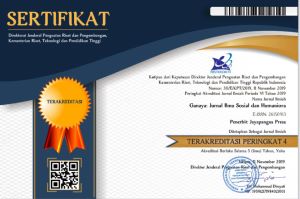Implementasi Analisis Kebutuhan Pelatihan Dalam Pengembangan Karyawan Di Unit Collection & Recovery, Permata Bank
DOI:
https://doi.org/10.37329/ganaya.v8i3.4476Keywords:
Training Need Analysis, Employee Development, Learning & Development, Training Effectiveness, Permata BankAbstract
This research analyzed the implementation of training need analysis (TNA) for employee development at Permata Bank's Collection & Recovery Unit in East Jakarta. The issue stemmed from a mismatch between training programs and employee needs, leading to suboptimal unit performance. The study aimed to describe training needs, TNA application, and influencing factors. Employing a descriptive qualitative case study method, data was gathered via interviews, observations, and documentation, validated through triangulation. Findings revealed TNA implementation was suboptimal due to L&D implementers' limited competence and insufficient employee involvement, resulting in irrelevant and ineffective training. Inhibiting factors included minimal management support, time constraints, and resistance to change, despite adequate training facilities. Recommendations included specialized TNA training for L&D, standardized TNA guidelines, benchmarking, and regular evaluation for continuous improvement.
References
Alias, Z., Zawawi, E. M. A., Yusof, K., & Aris, N. M. (2014). Determining Critical Success Factors Of Project Management Practice: A Conceptual Framework. Procedia-Social and Behavioral Sciences, 153, 61-69.
Al Ruheili, H., & Al-Buraiki, S. A. (2025). Incorporating AI in Educational Leadership: Trends and Innovations. Hershey: IGI Global Scientific Publishing.
Arthur, W. J., Bennett, W. J., Edens, P. S., & Bell, S. T. (2003). Effectiveness Of Training In Organizations: A Meta-Analysis Of Design And Evaluation Features. Journal of Applied psychology, 88(2), 234-245.
Daga, A. K., & Prasetyo, P. S. (2023). Inovasi dan Tantangan: Kendala Implementasi Program Kota Tanpa Kumuh di Kelurahan Sukahaji, Bandung. Contemporary Public Administration Review, 1(1), 74-92
Daryanto, E., & Darwin, D. (2020). Needs analysis and implementation training management model development. Dalam Proceedings of the 3rd Annual Conference of Engineering and Implementation on Vocational Education, ACEIVE 2019 (16 November 2019, Universitas Negeri Medan, Sumatera Utara, Indonesia).
Dittmar, H., Bond, R., Hurst, M., & Kasser, T. (2014). The Relationship Between Materialism And Personal Well-Being: A Meta-Analysis. Journal of Personality and Social Psychology, 107(5), 879-924.
Ehsan, S. M. A., & Imam, Z. (2021). Analyzing the Effectiveness of Training Programs of BCS Administration Academy: Prospects and Challenges. Journal of Public Administration and Governance, 10(4), 73-99.
Fairman, B., Voak, A., & Sujatmaka, U. (2020). Training Needs Analysis Implementation: Dilemmas and Paradoxes. Managing Learning Organization in Industry 4.0, 136-142
Goldstein, I. L., & Ford, J. K. (2002). Training In Organizations: Needs Assessment, Development, And Evaluation. Belmont, CA: Wadsworth.
Grau-Gumbau, R., Agut-Nieto, S., Llorens-Gumbau, S., & Martínez-Martínez, I. M. (2002). Managerial Training Needs: A Study of Spanish Tourism Organisations. Tourism and Hospitality Research, 3(3), 234-244
Jach, E. A., & Carvajal, C. N. (2023). Evaluating The Effectiveness Of UndocuAlly Trainings: A Case Example In The State Of New York. New Directions for Higher Education, 2023(203), 109-123.
Ju, B., & Li, J. (2019). Exploring The Impact Of Training, Job Tenure, And Education-Job And Skills-Job Matches On Employee Turnover Intention. European Journal of Training and Development, 43(4), 214-231.
León, F. (2018). Sense Of Ownership And Sense Of Agency In First-Person-Perspective Full-Body Illusions. Constructivist Foundations, 14(1), 105-107.
Markaki, A., Malhotra, S., Billings, R., & Theus, L. (2021). Training Needs Assessment: Tool Utilization And Global Impact. BMC Medical Education, 21(1), 2-20.
McKillip, J. (2001). Case Studies In Job Analysis And Training Evaluation. International Journal of Training and Development, 5(4), 283-289.
Mei, L., Li, Y., Huang, S., Xue, G., Chen, C., & Dong, Q. (2008). Age Effect on a Short-Term Training in Discriminating a Non-Native Phonemic Contrast. Journal of Psychological Development and Education, 24, 89-93.
Rahmana, A., & Sukaya, Y. (2020). Training Needs Analysis: Suggested Framework for Identifying Training Need. International Journal of Psychosocial Rehabilitation, 24(2).
Reed, J., & Vakola, M. (2006). What Role Can A Training Needs Analysis Play In Organisational Change?. Journal of Organizational Change Management, 19(3), 393-407.
Suhaedin, E., Oriza, W., Ambiyar, A., & Rizal, F. (2024). Analisis Dampak Program Pelatihan Guru Terhadap Kualitas Pengajaran Di SMK. Journal on Education, 7(1), 3629-3638.
Turwelis, T., & Kurniadi, D. A. (2019). The Implementation of Training Need Analysis for the Improvement of Apparatus Training Quality. Proceedings of the 2nd International Conference on Research of Educational Administration and Management (ICREAM 2018), 269-273.
Zulkifli, H., Razak, K. A., & Mahmood, M. R. (2018). The Usage Of ADDIE Model In The Development Of A Philosophical Inquiry Approach In Moral Education Module For Secondary School Students. Creative Education, 9(14), 2111-2124.
Downloads
Published
How to Cite
Issue
Section
License
Copyright (c) 2025 Muhammad Rafly, Durotul Yatimah, Anan Sutisna (Author)

This work is licensed under a Creative Commons Attribution-ShareAlike 4.0 International License.
An author who publishes in the Ganaya : Jurnal Ilmu Sosial dan Humaniora agrees to the following terms:
- Author retains the copyright and grants the journal the right of first publication of the work simultaneously licensed under the Creative Commons Attribution-ShareAlike 4.0 License that allows others to share the work with an acknowledgement of the work's authorship and initial publication in this journal
- Author is able to enter into separate, additional contractual arrangements for the non-exclusive distribution of the journal's published version of the work (e.g., post it to an institutional repository or publish it in a book) with the acknowledgement of its initial publication in this journal.
- Author is permitted and encouraged to post his/her work online (e.g., in institutional repositories or on their website) prior to and during the submission process, as it can lead to productive exchanges, as well as earlier and greater citation of the published work (See The Effect of Open Access).
Read more about the Creative Commons Attribution-ShareAlike 4.0 Licence here: https://creativecommons.org/licenses/by-sa/4.0/.








